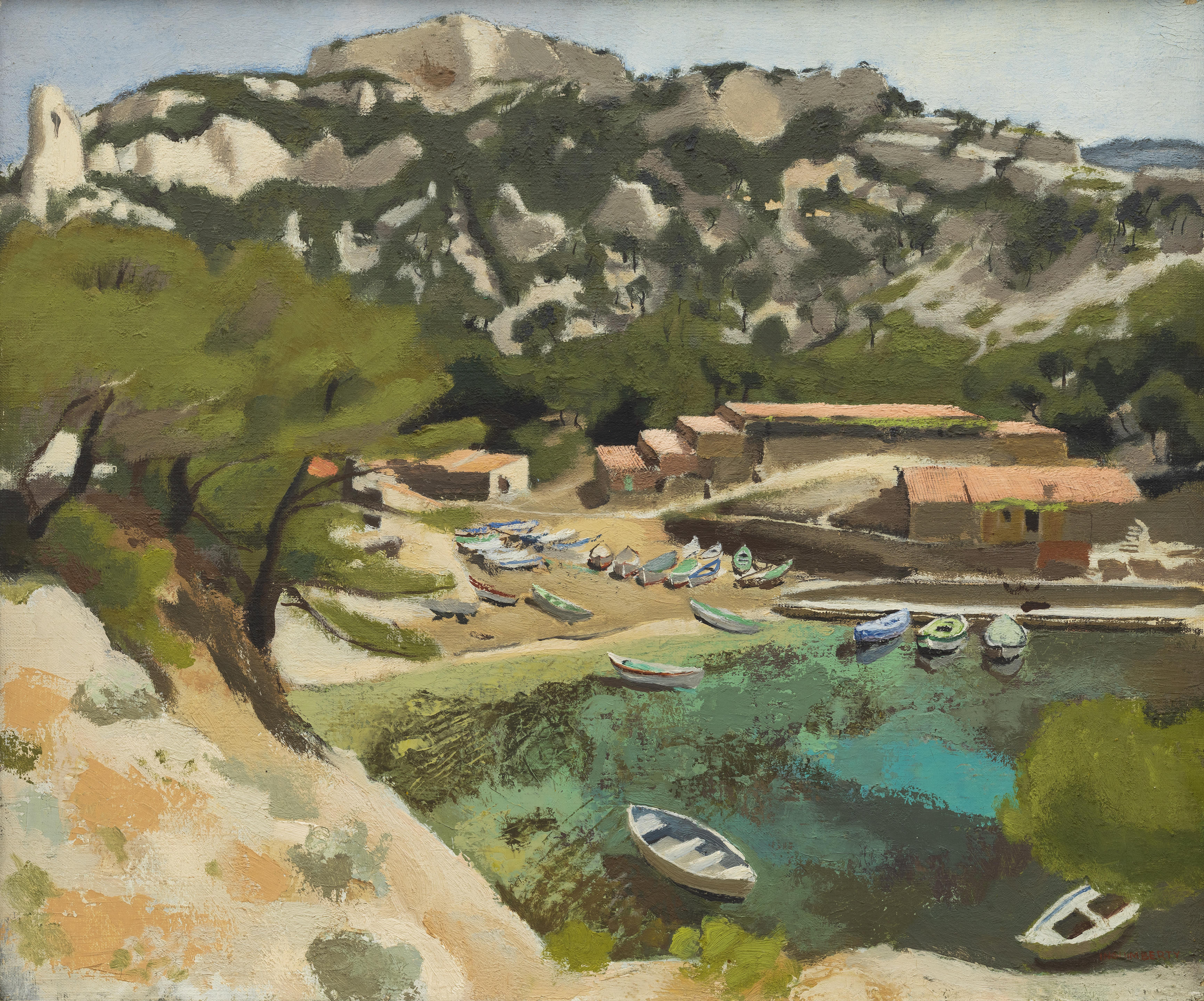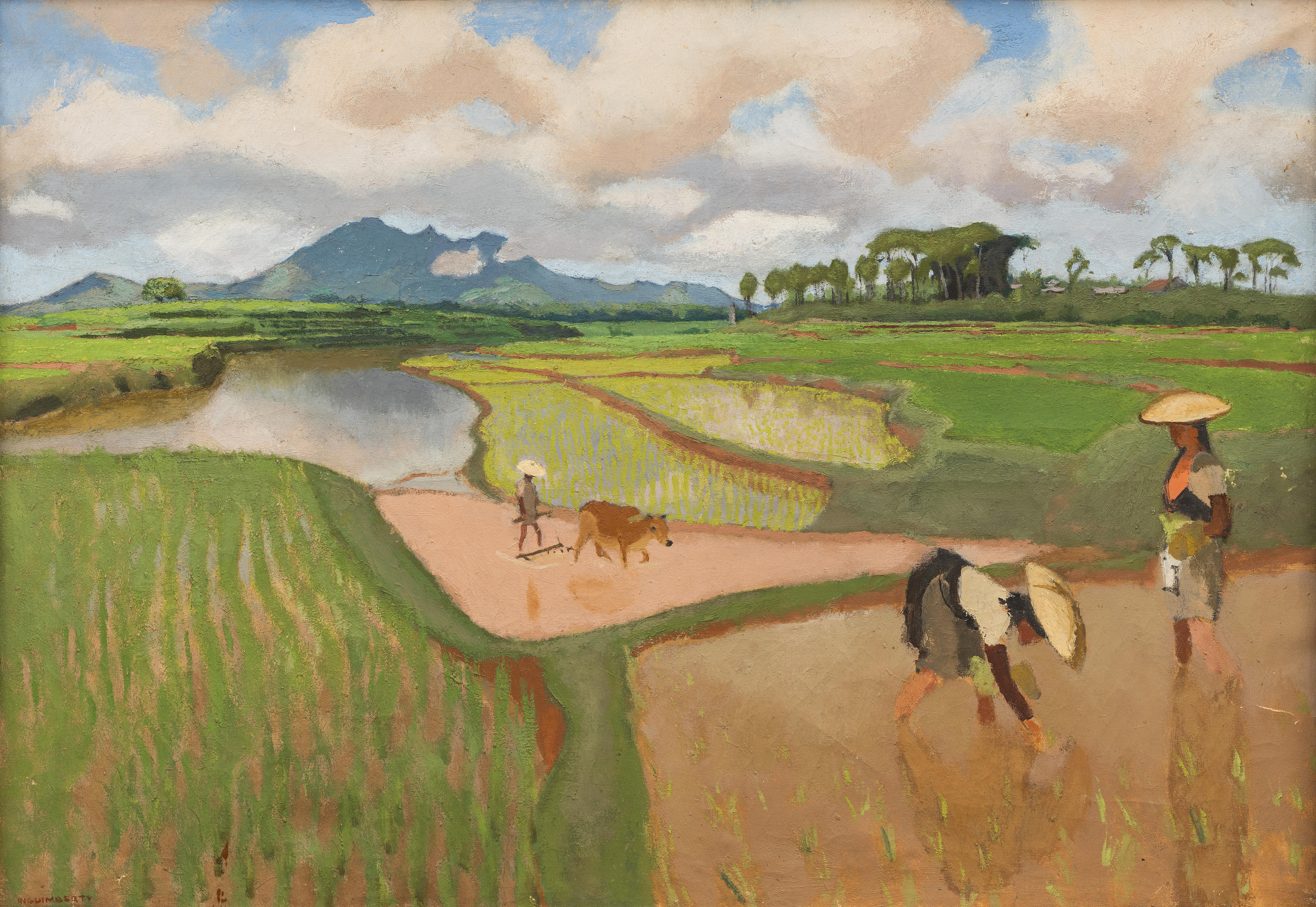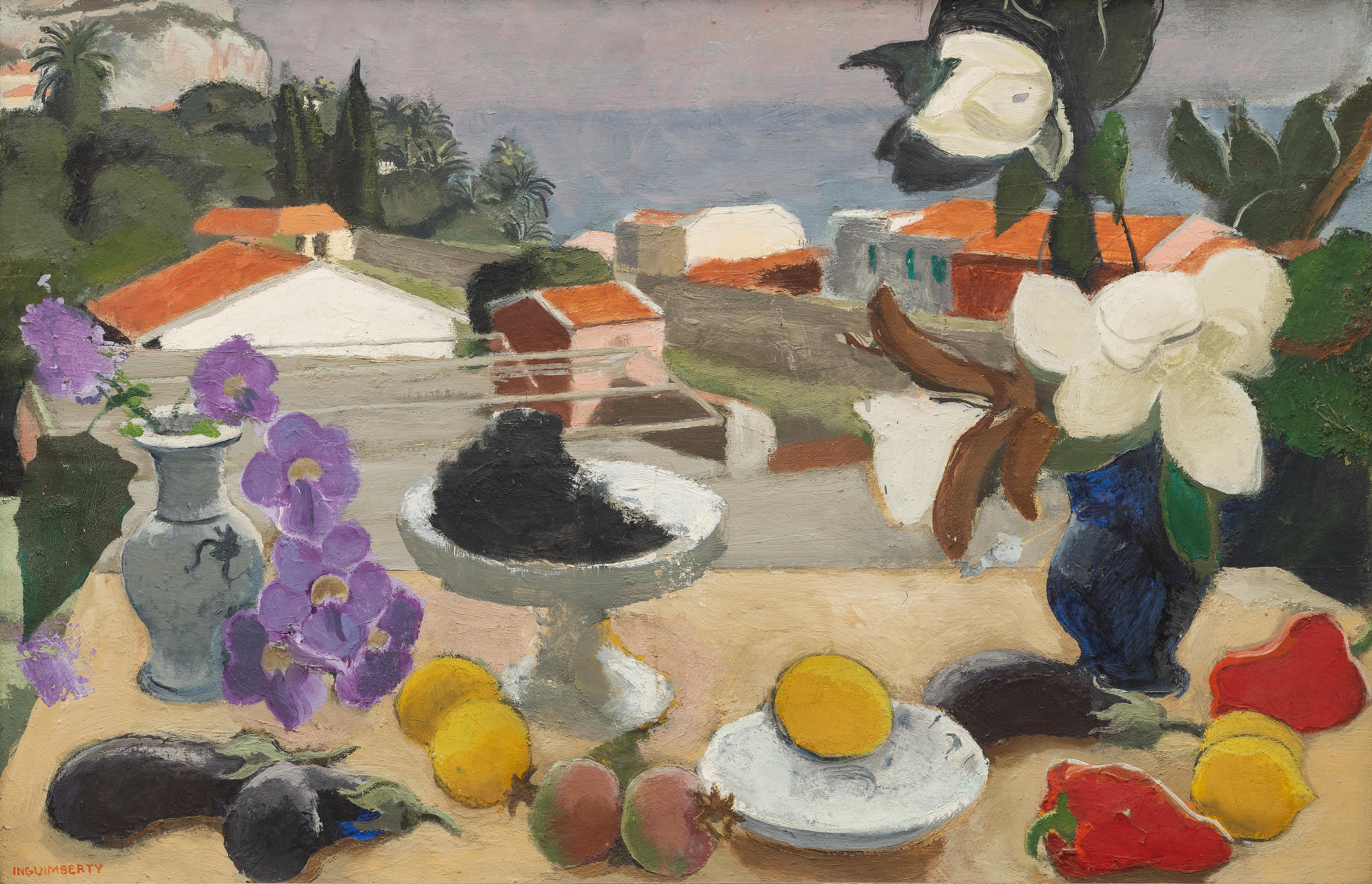Au bord de l'eau, 1933 Huile sur toile, signée et datée en bas à gauche 65 x 92 cm - 25 1/2 x 36 1/4 in. Oil on canvas, signed and dated lower left 河畔, 1933年 画布油画,署名与日期于左下方 PROVENANCE Collection privée, Paris. Acquis directement auprès de l'artiste à Hanoï et conservé depuis. 来源 巴黎 私人收藏 直接于河南艺术家处购得并收藏至今 The professional career of a painter usually reflects the turpitudes of his private life. An artist feels and interprets the world around him intensely, and every significant experience in his life has some kind of impact upon his work. Because of the physical and psychological displacement it involves, travel seems to be the most familiar of these events. The painter who retains our interest here, Joseph Inguimberty, was an artist particularly affected by this phenomenon in the sense that far more than a journey, a whole period of his life unfolded abroad, in the distant lands of Indochina. Born in Marseille, Inguimberty had a highly successful early career as a landscapist from the age of thirty, when he received the Prix National de Peinture at the Salon of 1924. After a four-year European «tour», he grasped the opportunity to teach the decorative arts at the Ecole des Beaux-Arts in Hanoi, at the suggestion of its director, Victor Tardieu, and the artist Nam Son. Inguimberty certainly taught classes, but his fascination with temple decorations also led him to in-depth studies on the art of lacquering. He spent twenty years of his life in this way, until 1946, criss-crossing the Mekong Delta and depicting landscapes and scenes of local life. He also painted women, both typical peasant women in hats and, for the first time, nude models posing modestly in private apartments. His attitude and thus his painting were strongly influenced by this period. Even after his final return to the south of France, his work retained distinct traces of this Asian atmosphere. The work presented today was bought directly from the artist in Indochina. It reflects the two facets of his work: one Provençal, the other Asian. Though moving between olive groves and paddy fields, his painting is imbued with the same spirit: a straightforward approach focused on the exploration of light and colour. It is also poetic and touching, because he truly rendered his passion for what he saw through his brush. Typical of his Asian period, it remarkably illustrates the talent of an artist whose painting was genuinely uplifted through the years he spent in Asia. JOSEPH INGUIMBERTYl La carrière professionnelle d'un peintre est généralement liée aux turpitudes de sa vie privée. Un artiste ressent et retranscrit le monde qui l'entoure de la façon la plus intime qui soit et chacun des jalons qui parsème sa vie a une incidence plus ou moins grande sur son oeuvre. Parmi ces évènements, le voyage, par le dépaysement physique et psychologique qu'il implique, semble le plus familier. Le peintre qui nous intéresse ici, Joseph Inguimberty est un artiste particulièrement concerné par ce phénomène dans la mesure où plus qu'un voyage, c'est un morceau de sa vie qui s'est écrit à l'étranger, dans les lointaines contrées d'Indochine. Natif de Marseille, Inguimberty voit sa jeune carrière de peintre paysagiste couronnée de succès, dès l'âge de trente ans, lorsqu'il reçoit pour son travail le prix National de peinture au Salon de 1924. Après un «tour» européen de quatre années, il saisit l'opportunité qui lui est offerte d'enseigner en arts décoratifs à l'Ecole des Beaux-Arts de Hanoï, sous l'impulsion de Victor Tardieu, qui en est l'administrateur, et de l'artiste Nam Son. Inguimberty dispense des cours, certes, mais, subjugué par les décors des temples, il mène aussi des recherches poussées sur l'art de la laque. Il passe ainsi vingt années de sa vie, jusqu'en 1946, à arpenter le delta du Mékong, à dépeindre les paysages, les scènes de vie locales, et s'adonne également à la représentation des femmes, que ce soit la typique paysanne au chapeau ou, pour la première fois, le modèle
Au bord de l'eau, 1933 Huile sur toile, signée et datée en bas à gauche 65 x 92 cm - 25 1/2 x 36 1/4 in. Oil on canvas, signed and dated lower left 河畔, 1933年 画布油画,署名与日期于左下方 PROVENANCE Collection privée, Paris. Acquis directement auprès de l'artiste à Hanoï et conservé depuis. 来源 巴黎 私人收藏 直接于河南艺术家处购得并收藏至今 The professional career of a painter usually reflects the turpitudes of his private life. An artist feels and interprets the world around him intensely, and every significant experience in his life has some kind of impact upon his work. Because of the physical and psychological displacement it involves, travel seems to be the most familiar of these events. The painter who retains our interest here, Joseph Inguimberty, was an artist particularly affected by this phenomenon in the sense that far more than a journey, a whole period of his life unfolded abroad, in the distant lands of Indochina. Born in Marseille, Inguimberty had a highly successful early career as a landscapist from the age of thirty, when he received the Prix National de Peinture at the Salon of 1924. After a four-year European «tour», he grasped the opportunity to teach the decorative arts at the Ecole des Beaux-Arts in Hanoi, at the suggestion of its director, Victor Tardieu, and the artist Nam Son. Inguimberty certainly taught classes, but his fascination with temple decorations also led him to in-depth studies on the art of lacquering. He spent twenty years of his life in this way, until 1946, criss-crossing the Mekong Delta and depicting landscapes and scenes of local life. He also painted women, both typical peasant women in hats and, for the first time, nude models posing modestly in private apartments. His attitude and thus his painting were strongly influenced by this period. Even after his final return to the south of France, his work retained distinct traces of this Asian atmosphere. The work presented today was bought directly from the artist in Indochina. It reflects the two facets of his work: one Provençal, the other Asian. Though moving between olive groves and paddy fields, his painting is imbued with the same spirit: a straightforward approach focused on the exploration of light and colour. It is also poetic and touching, because he truly rendered his passion for what he saw through his brush. Typical of his Asian period, it remarkably illustrates the talent of an artist whose painting was genuinely uplifted through the years he spent in Asia. JOSEPH INGUIMBERTYl La carrière professionnelle d'un peintre est généralement liée aux turpitudes de sa vie privée. Un artiste ressent et retranscrit le monde qui l'entoure de la façon la plus intime qui soit et chacun des jalons qui parsème sa vie a une incidence plus ou moins grande sur son oeuvre. Parmi ces évènements, le voyage, par le dépaysement physique et psychologique qu'il implique, semble le plus familier. Le peintre qui nous intéresse ici, Joseph Inguimberty est un artiste particulièrement concerné par ce phénomène dans la mesure où plus qu'un voyage, c'est un morceau de sa vie qui s'est écrit à l'étranger, dans les lointaines contrées d'Indochine. Natif de Marseille, Inguimberty voit sa jeune carrière de peintre paysagiste couronnée de succès, dès l'âge de trente ans, lorsqu'il reçoit pour son travail le prix National de peinture au Salon de 1924. Après un «tour» européen de quatre années, il saisit l'opportunité qui lui est offerte d'enseigner en arts décoratifs à l'Ecole des Beaux-Arts de Hanoï, sous l'impulsion de Victor Tardieu, qui en est l'administrateur, et de l'artiste Nam Son. Inguimberty dispense des cours, certes, mais, subjugué par les décors des temples, il mène aussi des recherches poussées sur l'art de la laque. Il passe ainsi vingt années de sa vie, jusqu'en 1946, à arpenter le delta du Mékong, à dépeindre les paysages, les scènes de vie locales, et s'adonne également à la représentation des femmes, que ce soit la typique paysanne au chapeau ou, pour la première fois, le modèle










.jpg)

.jpg)
.jpg)
.jpg)
Testen Sie LotSearch und seine Premium-Features 7 Tage - ohne Kosten!
Lassen Sie sich automatisch über neue Objekte in kommenden Auktionen benachrichtigen.
Suchauftrag anlegen